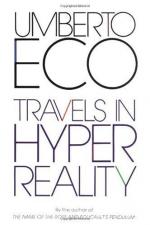
|
| Name: _________________________ | Period: ___________________ |
This test consists of 15 multiple choice questions and 5 short answer questions.
Multiple Choice Questions
1. What does Eco define as the fear of open or white space that is remedied by filling an entire piece of art with excessive detail in a neurotic fashion?
(a) Psychopainthic.
(b) Horror vacui.
(c) Brush mania.
(d) Particle overload.
2. Eco asserts that America has its own "Fortresses of Solitude" and it is the realm in which what is found?
(a) Black holes.
(b) Hyper reality.
(c) Hermits.
(d) Prisoners.
3. Where is the J. Paul Getty Museum located?
(a) San Jose, California.
(b) Los Angeles, California.
(c) Sacramento, California.
(d) Malibu, California.
4. Where was Marshall McLuhan born?
(a) Edmonton, Alberta.
(b) Whitehorse, Yukon Territory.
(c) Vancouver, British Columbia.
(d) Toronto, Ontario.
5. Eco asserts that because of the multinational arrangement, there is no head of a particular government or country that can be toppled in order to change what?
(a) The status quo.
(b) The military.
(c) The family unit.
(d) The arts world.
6. The Middle Ages was a period of European history from the 5th century to what century?
(a) 15th.
(b) 8th.
(c) 6th.
(d) 7th.
7. Who created Superman?
(a) Mike Mignola.
(b) Gail Simone.
(c) Jerry Siegal.
(d) Darwyn Cooke.
8. When was Umberto Eco born?
(a) 1939.
(b) 1932.
(c) 1928.
(d) 1925.
9. What were a Marxist-Leninist terrorist group based in Italy and active, via a number of political assassinations, during the "Years of Lead"?
(a) The Red Brigades.
(b) The Red Curtain.
(c) The Red Cross.
(d) The Red Coats.
10. When was Superman created?
(a) 1932.
(b) 1922.
(c) 1917.
(d) 1923.
11. Eco proposes that tourists at Disney must have a certain passivity and behave as what in order to enjoy themselves?
(a) Wild animals.
(b) Consumers.
(c) Robots.
(d) Children.
12. Ego proposes that our fascination with the Middle Ages is related to a desire to do what?
(a) Understand the past.
(b) Learn.
(c) Predict the future.
(d) Examine our origins.
13. What refers to a sovereign state which is viewed as comprising two or more nations?
(a) Multinational state.
(b) Partner state.
(c) Sister state.
(d) Companion state.
14. What ideology of progress is focused on improving society by means of revolution?
(a) Negativistic-factual.
(b) Positivistic-technological.
(c) Materialistic-historical.
(d) Religion.
15. In what country did Che Guevara head a massive revolution?
(a) Haiti.
(b) Cuba.
(c) Jamaica.
(d) Argentina.
Short Answer Questions
1. Where is Disneyland Park located?
2. According to Eco, hyper reality serves to confuse the boundaries of what?
3. What is the fourth type of Middle Ages presented by Eco in order to approach the subject in a disciplined way?
4. Eco creates a language for talking about communication transmission in which there is a source that sends out a signal via a transmitter through what?
5. Eco discusses the current cultural fascination with the Middle Ages that he refers to as what?
|
This section contains 460 words (approx. 2 pages at 300 words per page) |

|




